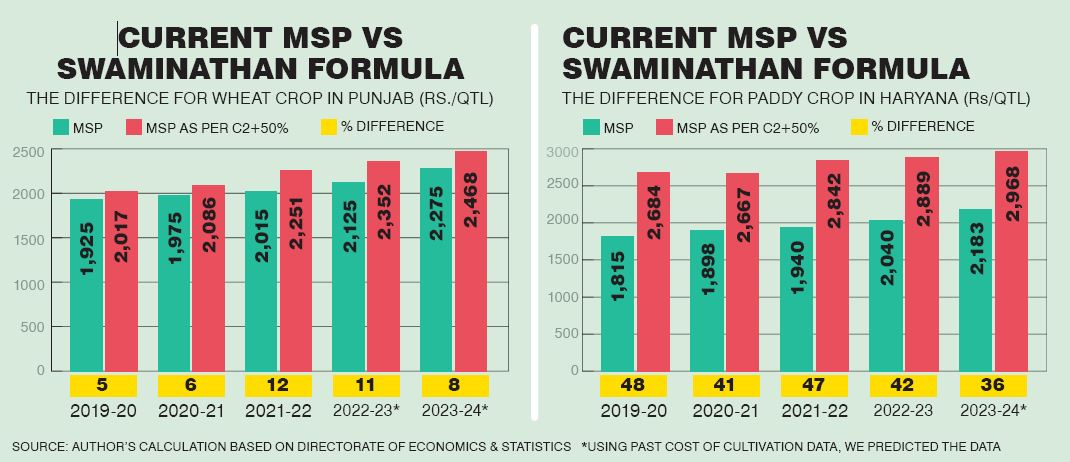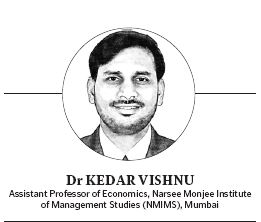Rewind: Fair demand from farmers
Implementing the Swaminathan Committee formula will significantly raise MSP, and, in turn, farmers’ profitability

By Dr Kedar Vishnu
Farmers are back on the streets once again. After forcing the central government to withdraw the three farm laws in 2021, thousands of farmers are trying to reach the national capital with demands for legalising the Minimum Support Price (MSP) for all the crops and enforcing the recommendations of the Swaminathan committee formula.
Also Read
In addition to this, they expect the government to give them a complete debt waiver, a pension plan and the withdrawal of the Electricity Amendment Bill 2020. But at the heart of the protest is the demand for MSP as per the recommendations made by Prof Swaminathan’s Committee in 2006. Farmers want a law that guarantees MSP for all crops. As of now, the government is offering MSP for 23 crops but there is no legal provision.
MSP Makes Sense
The MSP is the amount the government pays farmers for their crops, guaranteeing them a profit for their harvest. In times of market volatility or when market prices drop below the MSP, this price serves as a safety net for farmers, guaranteeing they get paid fairly for their goods. The 13 kharif crops that are currently covered under MSP include groundnut, cotton, soyabean, rice, ragi, moong, urad, cotton, sunflower and sesamum. Seven rabi crops — wheat, barley, gam, Rrapeseeds, mustard, safflower and toria — are covered under MSP. The government also declares MSP for jute and coconut to further promote diversification mainly from South India.
How MSP is Decided
Since 1970-71, the Ministry of Agriculture’s Directorate of Economics & Statistics has been conducting a Comprehensive Scheme for Studying the Cost of Cultivation of Principal Crops in India to produce estimates of the costs associated with the cultivation and production of the principal crops for precise planning.
The Commission for Agricultural Costs & Prices (CACP) is responsible for preparing the MSP for the 23 crops. But the final decision is taken by the Prime Minister’s office.
As of now, the government considers:
A2 + Family labor + 50 per cent higher value for deciding the MSP.
A2 includes paid-out costs incurred by the farmers on hired human and bullock labour, hired machinery, seed, insecticides, pesticides, fertilizer, depreciation on implements, irrigation charges and interest on working capital. The government also takes into account the price of other crops, the state of the economy and the terms of trade between the agricultural and non-agricultural sectors.
The Swaminathan Committee strongly suggests the government should consider C2 cost+ 50 per cent higher value for deciding the MSP. C2 includes A2 + other four important costs. These are:
- Interest on the value of owned fixed capital assets (excluding land)
- Rent value of own land and rent paid for leased-in land
- Imputed value of family labour and
- Value of management input at 10% of the total cost
A significantly larger MSP for crops would have been obtained if we applied Swaminathan’s formula. However, the suggestion by the Father of India’s Green Revolution was rejected by the government.
The suggestion made by Prof Swaminathan would have greatly aided us in resolving the agrarian crisis. It would have benefited farmers to spend more on agricultural equipment, diversify their cropping strategy and increase agricultural production if they had been paid a fair price for their crops.
On Applying Swaminathan Formula
Several policymakers have written on Prof Swaminathan’s suggested formula and how it would have helped farmers receive greater prices. But not many have tried to look at what extent it would have enhanced the price received by farmers. Here, I have attempted to find out how much the profitability of farmers increases through the MSP.
The research is based on data released by the central government’s Directorate of Economics and Statistics regarding the crops that receive MSP. The recent cost of cultivation data is only accessible for the year 2021-22, whereas the MSP data is available until 2023-24. I estimated all the costs of cultivation for 2022-23 and 2023-24 based on the most recent five-year data. The cost of cultivation in the State that contributes the most to the area or production of a certain crop has been taken into consideration, as there is currently no data available on the cost of cultivation for the national average. Since wheat is grown by the majority of farmers in Punjab, the cost of production there was taken into account while calculating the current MSP and the MSP that Prof Swaminathan advocated. (See figure 1)

As per our estimate, the impact of greater MSP would have differed depending on the crop, with rice benefiting from a minimum of 6% and sunflower benefiting the highest of 117%. The government announced an increase in MSP ranging from 2% to 10.4% for all crops during the 2023-24 marketing season. Gram showed the lowest increase while moong the largest. Comparing the current fiscal 2023-24 with the previous year, the MSP for wheat and paddy increased 7%. For the majority of crops, the government has increased the MSP only by an average of 6-7%. However, farmers’ production costs have climbed significantly as against the MSP. Farmers expected the government to raise the MSP at a significantly faster rate following the repeal of the farm law.
How Increase in MSP will help Farmers
Using the Swaminathan formula, our projected estimation revealed an MSP of Rs 2,968 per quintal (with a 36% increase) for the paddy crop in Haryana. The paddy farmers in Punjab will receive an MSP of Rs 2,183 per quintal with the existing method. Punjab has had a smaller growth mostly because its production costs are lower than those of Haryana. Likewise, with regard to wheat, Punjab farmers would have received an MSP of Rs 2,468 per quintal, an 8% increase over the current formula of Rs 2,275 per quintal. The primary reason why farmers in Punjab and Haryana are on strike is because they anticipate higher MSP — 36-48% for paddy crops and 5-12% for wheat. It’s interesting to note that Haryana farmers stand to gain more from the Swaminathan formula for paddy crops than Punjab farmers.

Why Government may not legalise MSP for all crops
Based on our study, it is evident that farmers stand to gain significantly from the Swaminathan Committee formula. This presents the greatest chance for the government to support farmers in increasing their MSP by assisting them in overcoming financial obstacles and promoting crop diversification. Due to extreme price volatility, farmers have been cultivating the same crops over and over, which has a negative effect on the fertility of the ground. The current government’s primary goal would also be achieved by meeting the pledge to double farmers’ income.
Meanwhile, many experts fear that an MSP law might be anti-farmers. The regulation would not incentivise private companies to purchase agricultural products at a price higher than MSP. However, in developing countries like India, farmers need more assistance. With the younger generation abandoning agriculture primarily because of price fluctuations and the inability to make ends meet, the future of Indian agriculture isn’t looking very bright.
One feels less optimistic as the government has consistently lowered the budgetary allocation for the agricultural sector for the past two years — Rs 1.275 lakh crore has been earmarked for 2024-25 as against Rs 1.267 lakh crore last year, a meagre 0.65% increase. Furthermore, it has not prioritised developing rural infrastructure or establishing a link between farmers and metropolitan consumers. The third marketing revolution is necessary for agricultural industries. Thus far, our efforts have not succeeded in bringing down intermediaries in agricultural markets or expanding the agro and food processing industries beyond the point at which farmers can raise their earnings.
The government might not be able to provide MSP for all the crops since it will not buy all of the goods that farmers produce. Only 23 crops, representing 28-29% of total agricultural products, are eligible for MSP. Currently, the government purchases a greater amount of rice and wheat from farmers compared to other crops, mostly benefiting a small number of States. Nonetheless, the government can step in to raise the MSP for crops that are currently in production. In addition, it may consider reworking the Farmers (Empowerment and Protection) Agreement on Price Assurance and Farm Services Act, 2020, to increase revenue with significant adjustments. If the procurement price is raised, farmers can become self-sufficient rather than rely on the government. Long-term support for more welfare-oriented programmes might not be able to assist India in boosting the productivity of its rural economy.
Highlights
Only 23 crops representing 28–29% of total agricultural products, are eligible for MSP
- 13 kharif crops include groundnut, cotton, soybean, rice, ragi, moong, urad, sunflower and sesamum
- 7 rabi crops are Wheat, Barley, Gram, Rapeseeds, Mustard, Safflower and Toria
- Government also declares MSP for jute and coconut to further promote diversification mainly from South India.
The government buys a greater amount of rice and wheat from farmers compared with other crops, mostly benefiting a small number of States
The third marketing revolution is necessary for the agri industries as our efforts have not succeeded in bringing down intermediaries in agricultural markets or expanding the processing sector
While the cost of production has significantly increased, MSP has not kept pace with this rise — MSP for wheat and paddy increased 7% in 2023-24 compared with the previous year, and for majority of crops, the hike is only by an average of 6

Related News
-
Telangana’s paddy procurement falls short despite record harvest
-
Bandi Sanjay says Revanth Reddy hatching conspiracy to malign Allu Arjun
-
Delhi, Uttar Pradesh enter basketball final of Sub-Junior National Basketball Championship
-
Sangareddy: Lagacherla farmers released from jail; Slam government for false cases
-
Cartoon Today on December 25, 2024
7 hours ago -
Sandhya Theatre stampede case: Allu Arjun questioned for 3 hours by Chikkadpallly police
8 hours ago -
Telangana: TRSMA pitches for 15% school fee hike and Right to Fee Collection Act
8 hours ago -
Former Home Secretary Ajay Kumar Bhalla appointed Manipur Governor, Kerala Governor shifted to Bihar
8 hours ago -
Hyderabad: Organs of 74-year-old man donated as part of Jeevandan
8 hours ago -
Opinion: The China factor in India-Nepal relations
9 hours ago -
Editorial: Modi’s Kuwait outreach
9 hours ago -
Telangana HC suspends orders against KCR and Harish Rao
9 hours ago




